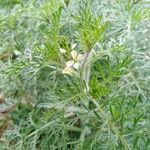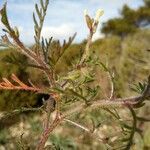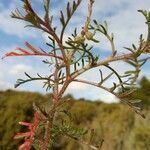Stems branched basally and distally, (0.5-)0.7-3.6(-4.5) dm. Basal leaves: petiole 1-4.5 cm; blade 3-6 lobes each side, 1.5-4 cm, terminal lobe linear to oblong, 0.3-1.5 cm × 0.5-1.5 mm, margins entire. Cauline leaves similar to basal. Fruiting pedicels 2.5-4 mm. Flowers: sepals 4-5 mm; petals 6.5-8 × 1-2 mm; median filaments 3.5-4 mm; anthers 0.5-0.8 mm. Fruits reflexed; proximal segment broadly ovoid to subglobose, 3-4 × 2.5-3.5 mm; terminal segment cochleariform or ovate, 3-5 × 3-4 mm (margin incurved). Seeds 1.1-1.6 mm diam. 2n = 16.
Erect herb 5–40 cm tall, branching basally; hairs simple, setiform, deflexed. Leaves petiolate, bi-to tri-pinnatisect, the lobes linear-obtuse. Sepals 4–4.5 mm long. Petals 8–9 mm long, yellow, purple-veined. Anthers mucronate. Style leaf-like; stigma capitate. Silicula 6–7.5 mm long, pendulous, on pedicel 2.5–3 mm long; beak 3,5–4 mm long, 2–2.5 mm wide, sterile, compressed, leaf-like; valves 2.5–3.5 mm long, 3–4 mm wide, subglobular, 3-veined, the veins hairy; seeds 3–4 per locule, subglobular, 1–1.5 mm long, dark brown.
An annual herb. The leaves are alternate and in a ring. They can be divided. The flowers are cream, purple or white.



